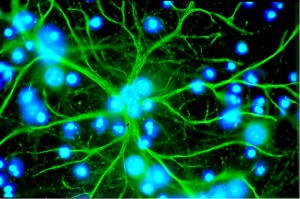Forming a memory involves altering inter-neuronal connections. This is known as synaptic plasticity. This week, a group of researchers at Florida’s Scripps Research Institute has published evidence for a role of microRNAs (miRNAs) in this process.
The miRNAs are thought to act in the amygdala, a brain structure that is important for emotional memory. The group measured the levels of miRNAs in the amygdala in rats before and after they underwent fear conditioning, during which they learn to associate a certain stimulus with a shock, laying down aversive memories. By using a microarray to measure the miRNAs, they found that half of all known miRNAs are expressed in the amygdala. This number changes after learning.
MicroRNAs are small fragments of RNA (pieces of genetic information similar to DNA). They normally lead to reduced gene expression by binding to messenger RNAs, which are important in protein synthesis. In the current study, they found that several of the microRNAs that were reduced after learning were found to have a role in repressing proteins involved in plasticity (and therefore memory). They identified one particular molecule, miR-182, which was present in very low levels before conditioning and further decreased during learning, but nevertheless seemed to have an important effect.
They found that it represses actin-regulating proteins, so during learning when its expression is reduced these proteins can act on actin. Actin is part of the scaffold that holds cells together (known as the cytoskeleton), and altering this cytoskeleton is how neurons are altered in synaptic plasticity. Therefore, the reduction in miRNAs would allow actin-regulating proteins to mediate synaptic plasticity.
These findings show that miRNAs have a more important role in memory formation than previously thought. It may lead to further unlocking of elusive memory mechanisms, possibly eventually leading to treatments for memory problems.
Griggs, E. M., Young, E. J., Rumbaugh, G., & Miller, C. A., MicroRNA-182 Regulates Amygdala-Dependent Memory Formation, The Journal of Neuroscience, 23 January 2013, 33(4), 1734-1740
